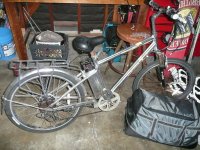Bob K
10 W
I picked up this bike for forty bucks.
It has a nimh pack and charger that works well.
It has a li (?) pack that does not charge.
The bike is a beach cruiser ( read: corroded ) that works well.
It is 100% operational, almost no miles and the bearings are ALL smooth and
quiet! The motor functions normally and is quiet. It operates on the
twist grip normally.
Pros: Cheap, fully functional, light weight.
Cons: 250 watts @ 24 v. corroded ( some call that "patina" , yeah, right)
Options: I have a maximum of 14S 10 P of 1835 2.5ahr Sanyo cells just sitting around
ready to be made up into a pack.
Question: Does anyone have any experience with this bike/motor and how much I can over-volt
the motor and controller without buying or blowing anything up? I have only short , moderate hills
and cooling time in between those short moderate hills.
Goal: I do not want to fry anything on this light weight ( cough, cough, cheap) bike.
but, for forty bucks, I am willing to get it "toasty" just for fun. Anyone?
It has a nimh pack and charger that works well.
It has a li (?) pack that does not charge.
The bike is a beach cruiser ( read: corroded ) that works well.
It is 100% operational, almost no miles and the bearings are ALL smooth and
quiet! The motor functions normally and is quiet. It operates on the
twist grip normally.
Pros: Cheap, fully functional, light weight.
Cons: 250 watts @ 24 v. corroded ( some call that "patina" , yeah, right)
Options: I have a maximum of 14S 10 P of 1835 2.5ahr Sanyo cells just sitting around
ready to be made up into a pack.
Question: Does anyone have any experience with this bike/motor and how much I can over-volt
the motor and controller without buying or blowing anything up? I have only short , moderate hills
and cooling time in between those short moderate hills.
Goal: I do not want to fry anything on this light weight ( cough, cough, cheap) bike.
but, for forty bucks, I am willing to get it "toasty" just for fun. Anyone?


